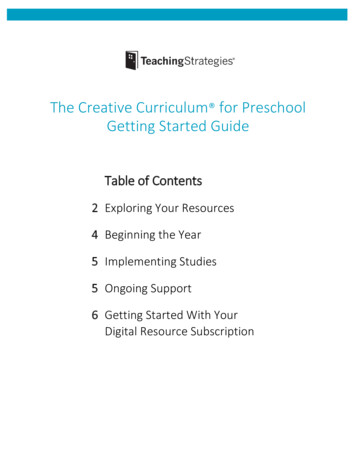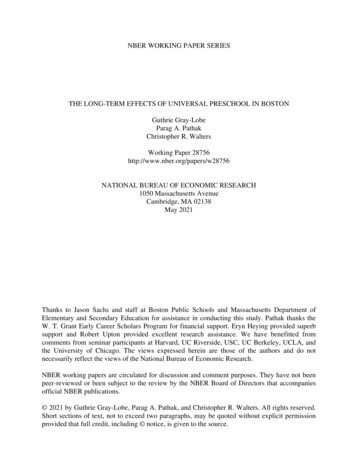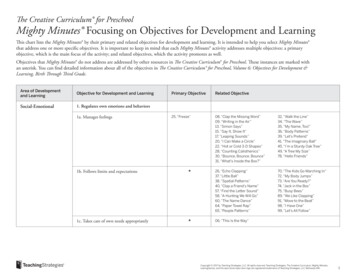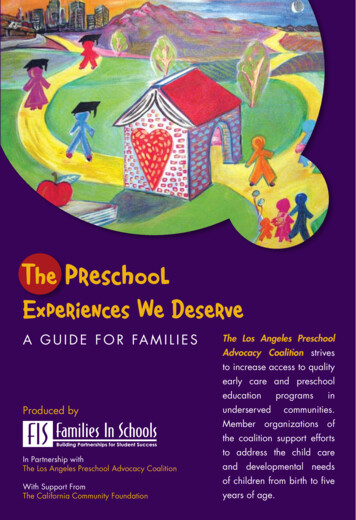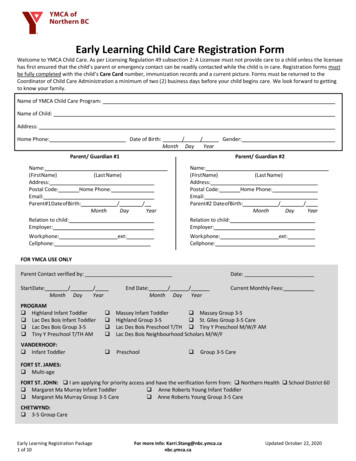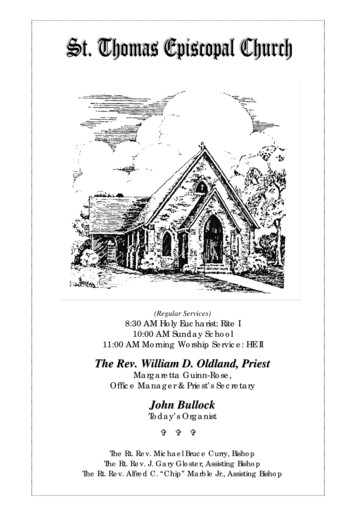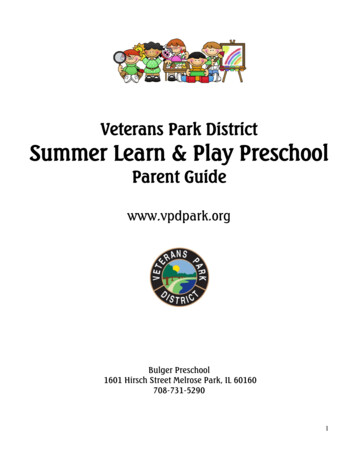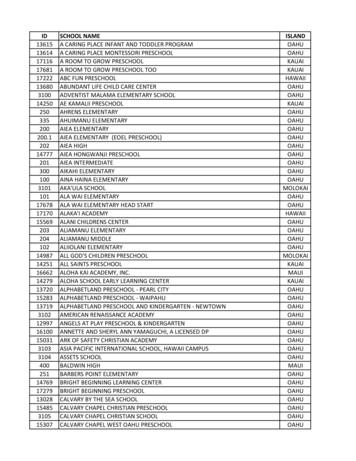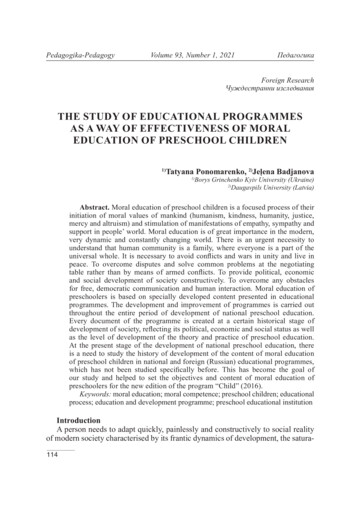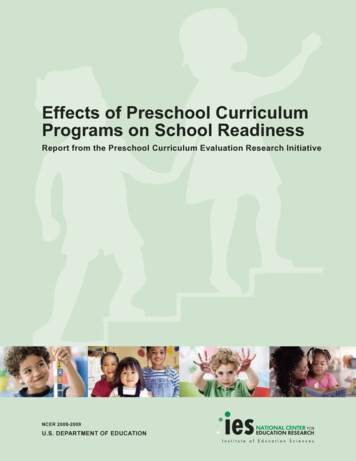
Transcription
Effects of Preschool CurriculumPrograms on School ReadinessReport from the Preschool Curriculum Evaluation Research initiativeNCER 2008-2009U.S. DEPaRtmENt of EDUCatioN
Effects of Preschool CurriculumPrograms on School ReadinessReport from the Preschool Curriculum Evaluation Research InitiativeJuly 2008Preschool Curriculum Evaluation Research ConsortiumNCER 2008-2009U.S. Department of Education
This report was prepared for the National Center for Education Research, Institute of EducationSciences, under contract numbers ED-01-CO-0039/0005 (Mathematica Policy Research, Inc.), ED01-CO-0052/0004 (RTI International), and ED-04-CO0076/0007 (Synergy Enterprises, Inc.).DisclaimerThe opinions and positions expressed in this report are the authors’ and do not necessarily representthe opinions and positions of the Institute of Education Sciences or the U.S. Department ofEducation. Any references within the document to specific education products are illustrativeand do not imply endorsement of these products to the exclusion of other products that are notreferenced.U.S. Department of EducationMargaret SpellingsSecretaryInstitute of Education SciencesGrover J. WhitehurstDirectorNational Center for Education ResearchLynn OkagakiCommissionerJuly 2008This report is in the public domain. While permission to reprint this publication is not necessary, thecitation should be:Preschool Curriculum Evaluation Research Consortium (2008). Effects of Preschool CurriculumPrograms on School Readiness (NCER 2008-2009). Washington, DC: National Center for EducationResearch, Institute of Education Sciences, U.S. Department of Education. Washington, DC: U.S.Government Printing Office.This report is available for download on the IES website at http://ncer.ed.gov.Alternative FormatsOn request, this publication can be made available in alternative formats, such as Braille, large print,audiotape, or computer diskette. For more information, call the Alternative Format Center at (202)205-8113.
Preschool Curriculum Evaluation Research Consortium1Institute of Education Sciences (IES)Caroline EbanksAllen RubyUniversity of California, Berkeley3Anne CunninghamMarcia Davidson (RMC Research; University of Maine)Mathematica Policy Research (MPR), Inc.John LoveSarah AvellarSteve GlazermanSusan SprachmanUniversity of MissouriKathy R. ThornburgWayne MayfieldJohnetta MorrisonJacqueline ScottRTI InternationalIna WallaceRandall BenderRenate HoutsJun LiuMelissa RaspaHolly RhodesUniversity of North Carolina at CharlotteRichard G. LambertMartha Abbott-Shim (Quality Counts)Florida State UniversityChristopher J. LoniganChristopher SchatschneiderPurdue UniversityDouglas PowellNancy File (University of Wisconsin-Milwaukee)Success for All FoundationBette ChambersRobert SlavinUniversity of California, Berkeley2Prentice StarkeyAlice KleinDouglas Clements (University at Buffalo,State University of New York)Julie Sarama (University at Buffalo,State University of New York)University of New HampshireJeffrey S. PriestLeigh ZoellickUniversity of North FloridaCheryl FountainMadelaine CosgroveJanice WoodUniversity of Texas Health Science Centerat HoustonSusan LandryMichael AsselSusan GunnewigPaul SwankUniversity of VirginiaLaura JusticeKhara PenceAlice WigginsVanderbilt UniversityDale FarranMark Lipsey1 The members of the Preschool Curriculum Evaluation Research (PCER) Consortium include the principal investigators and coprincipal investigators from each of the 12 funded research projects, Institute of Education Sciences (IES) staff, and staff from RTIInternational (RTI) and Mathematica Policy Research (MPR), Inc., the evaluation contractors.2 This University of California, Berkeley research team partnered with researchers at the University at Buffalo, State University of NewYork to evaluate the Pre-K Mathematics supplemented with DLM Early Childhood Express Math software curriculum in California and NewYork.3 This University of California, Berkeley research team evaluated the Ready, Set, Leap! curriculum in New Jersey.iii
Page intentionally left blank.
AcknowledgmentsThe findings reported here are based on research conducted by the Preschool Curriculum EvaluationResearch (PCER) program research teams, the evaluation contractors, and Institute of Education Sciences(IES) staff. This report is a product of the collaborative efforts of the PCER Consortium. The PCERConsortium consists of research teams from each participating grantee site, IES staff, and the evaluationcontractors: RTI International (RTI) and Mathematica Policy Research (MPR), Inc. Appendix B of the reportwas authored by Randall Bender (RTI), Jun Liu (RTI), Ina Wallace (RTI), Melissa Raspa (RTI), and MargaretBurchinal (University of North Carolina at Chapel Hill).The PCER Consortium would like to acknowledge Dr. Susan J. Kontos who served as the principalinvestigator for the Project Approach (Wisconsin) evaluation study from July 2002 to September 2003. Dr.Kontos, one of the country’s leading researchers in early childhood education and care, died September 12,2003.We also acknowledge and thank Heidi Schweingruber and James Griffin for their contributions to the PCERprogram during their tenure at IES.We are grateful to the schools, teachers, parents, and the children who participated in our assessments,interviews, and observations. Without their cooperation, none of this research would have been possible.The listed authors represent only a part of the research team involved in this project. We would like to thankthe research staff at each grantee site, especially the grantees’ site coordinators who worked closely with thelocal preschool programs, kindergarten school staff, and the contractors’ data collection teams to facilitate thesuccessful collection of child-, parent-, teacher-, and classroom-level data. We appreciate the efforts of theclassroom observers and the child assessors who were critical to the successful completion of data collectionat each research site. We are also grateful to the many contractor staff members who have worked on datacollection and data analysis tasks over the duration of the study.The mention of trade names, commercial products, or organizations in the description of the projects, or thereporting of study findings, does not imply endorsement by the U.S. Government.v
Page intentionally left blank.
Disclosure of Potential Conflicts of InterestThe PCER Consortium consists of research teams (principal investigators and co-principal investigators fromeach grantee site), IES staff, and the evaluation contractors, Mathematica Policy Research (MPR), Inc. andRTI International (RTI). Most of the grantee research teams, IES staff, and contractor staff from MPR andRTI have no interests that could be affected by findings from the evaluation of the curricula that arehighlighted in this report.It is important to note that four of the PCER initiative research teams developed curricula that wereimplemented at their respective research sites. The Success for All Foundation (SFA) developed the CuriosityCorner curriculum, which was implemented in preschool classrooms in Florida, Kansas, and New Jersey. Dr.Christopher Lonigan and his colleagues at Florida State University developed the Literacy Express curriculum,which was implemented in public pre-kindergarten classrooms in Florida. Drs. Prentice Starkey and AliceKlein are the developers of the Pre-K Mathematics curriculum. Drs. Douglas Clements and Julie Sarama are thedevelopers of the DLM Early Childhood Express Math software. The Pre-K Mathematics curriculum and the DLMEarly Childhood Express Math software were implemented jointly in Head Start and public pre-kindergartenclassrooms in California and New York. Drs. Cheryl Fountain, Madelaine Cosgrove, and Janice Wood are onstaff at the Florida Institute of Education, University of North Florida, where the Early Literacy and LearningModel (ELLM) was developed. These researchers were selected to receive funding for their PCER researchprojects in a competitive grant application process. Each research team implemented its curriculum andconducted site-specific analyses examining the effects of these curricula on child outcomes. RTI and MPR,the evaluation study contractors, conducted independent evaluations of these and the other treatmentcurricula that were included in the PCER study. The developers/implementers of these curricula did notconduct the impact analyses that are summarized in this report. Members of the RTI data analysis teamcompleted the impact analyses.In addition to their role as developers and implementers, Drs. Starkey, Klein, Clements, Sarama, and Lonigandeveloped measures that were included in the PCER child assessment battery. Drs. Starkey and Kleindeveloped a preschool mathematics assessment, the Child Math Assessment (CMA) that was adapted for usein the PCER evaluation study. The Child Math Assessment-Abbreviated (CMA-A) was added to theassessment battery as a measure of children’s early mathematical knowledge and skills using manipulativematerials. The Building Blocks, Shape Composition task was also included in the child assessment battery. Thistask was adapted from the Building Blocks assessment tool, which was developed by Clements, Sarama, andLiu. The Elision subtest from the Preschool Comprehensive Test of Phonological and Print Processing (PreCTOPPP) was used in the pre-kindergarten year of the evaluation study. Dr. Christopher Lonigan and hiscolleagues developed the Pre-CTOPPP, Elision subtest. The assessment was not commercially available at thetime it was selected for inclusion in the study or during the data collection phase of the study. A revisedversion of the assessment became commercially available as the Test of Preschool Early Literacy (TOPEL) inJanuary 2007, after the PCER data collection. Dr. Lonigan has a financial interest in the commercial versionof this measure.Dr. Susan Landry and her colleagues at the Center for Improving the Readiness of Children for Learning andEducation (CIRCLE) developed one of the study’s classroom observation measures and advised on theselection of the child assessments. CIRCLE staff also trained PCER data collection teams to collectclassroom observation data using the Teacher Behavior Rating Scale (TBRS), but CIRCLE staff did notcollect the data. CIRCLE staff scored the classroom observation data that were collected using the TBRSmeasure.Data collection teams from MPR and RTI independently collected all of the data using the measures that arementioned here. The data analysis team completed descriptive and impact analyses using the scored data. Thedevelopers of these measures had no direct role in the completion of the descriptive analyses or the impactanalyses that are summarized in this report.vii
Page intentionally left blank.
GlossaryACF—Administration for Children and FamiliesANCOVA—Analysis of CovarianceArnett—Arnett Caregiver Interaction ScaleCMA-A—Child Math Assessment-Abbreviatedcontrol classrooms—Classrooms randomly assigned to the control condition. Classrooms where theprevailing or existing curriculum was in use during the course of the studycontrol curriculum—The prevailing/existing curriculum used by teachers in the control condition at eachsiteCTOPP—Comprehensive Test of Phonological Processing (CTOPP), Elision subtestECERS-R—Early Childhood Environment Rating Scale-RevisedECLS-K—Early Childhood Longitudinal Study, Kindergarten cohortELLM—Early Literacy and Learning ModelFACES—Family and Child Experiences SurveyFSU—Florida State Universityfull-day—Preschool program where children spend at least 6 hours per day in the preschool classroomGED—General Educational Developmentgrantee—Researcher funded by the Institute of Education Sciences, U.S. Department of Education, toconduct a site-specific study under the Preschool Curriculum Evaluation Research initiative. Grants wereawarded to investigators at a single institution or to co-investigators at multiple institutionshalf-day—Preschool program where children spend less than 6 hours per dayHead Start center—Preschool that is funded by the U.S. Administration for Children and Families HeadStart BureauICC—Intraclass correlationIES—Institute of Education Sciences, U.S. Department of EducationLBS—Learning Behaviors ScaleMDE—Minimum Detectable EffectsMPR—Mathematica Policy Research, Incix
Glossary—ContinuedMPR evaluation sites—Preschool Curriculum Evaluation Research research sites where Mathematica PolicyResearch, Inc. conducted data collectionPCER—Preschool Curriculum Evaluation ResearchPLBS—Preschool Learning Behaviors ScalePPVT—Peabody Picture Vocabulary Test, Third Edition (PPVT-III)Pre-CTOPPP—Preschool Comprehensive Test of Phonological and Print Processing, Elision subtestprivate pre-kindergarten—Preschool that is funded primarily through tuition or other nongovernmentalsourcepublic pre-kindergarten—Preschool that is part of a public school system or receives substantial publicfundingrandom assignment—Determination by lottery under supervision of a researcher whether a study subjectwill be placed in one experimental group or anotherrandomized trial—Research study in which subjects are randomly assigned to receive or not receiveinterventionsresearch site—Collection of preschool programs/classrooms in a specific geographic location that wererecruited by each grantee. Grantees implemented one or more preschool curricula at each research siteRTI—RTI InternationalRTI evaluation sites—PCER research sites where RTI International conducted data collectionSFA—Success for Allsite/grantee site—The geographic location of the research sitesSSRS—Social Skills Rating SystemSSRS Problem Behaviors—Social Skills Rating System, Problem Behaviors scaleSSRS Social Skills—Social Skills Rating System, Social Skills scaleTBRS—Teacher Behavior Rating ScaleTERA—Test of Early Reading Ability, Third Edition (TERA-3)TOLD—Test of Language Development-Primary, Third Edition (TOLD-P:3)treatment classroom—Classrooms randomly assigned to the treatment condition where an experimentalcurriculum was implemented and evaluatedx
Glossary—Continuedtreatment curriculum—One of the 14 intervention curricula that were implemented in treatmentclassroomsUNF—University of North FloridaWJ—Woodcock Johnson Achievement Test, 3rd Edition (WJ III)WJ Applied Problems/WJ Applied Problems test—Woodcock Johnson Achievement Test, 3rd Edition(WJ III), Applied Problems TestWJ Letter Word Identification/WJ Word Identification test—Woodcock Johnson AchievementTest, 3rd Edition (WJ III), Letter Word Identification TestWJ Spelling/WJ Spelling test—Woodcock Johnson Achievement Test, 3rd Edition (WJ III), Spelling Testxi
Page intentionally left blank.
ContentsPagePreschool Curriculum Evaluation Research Consortium . iiiAcknowledgments . vDisclosure of Potential Conflicts of Interest . viiGlossary . ixList of Tables . xxiList of Figures . xxixExecutive Summary . xxxiResearch Questions . xxxiStudy Design . xxxiiSample and Assignment to Condition . xxxiiMeasures . xxxvStudy Implementation . xxxviiiAnalysis . xxxixResults . xliChapter 1. An Overview of the Preschool Curriculum Evaluation Research Initiative . 1Study Background .1School Readiness and Later Academic Achievement .1Early Childhood Education .2The Preschool Curriculum Evaluation Research Initiative .3Research Questions.3Study Design .4Intervention and Control Curricula .4Sample and Random Assignment to Condition .6Measures .9Study Implementation .16Timeline of Implementation .17Response Rates, Attrition, and Mobility .23Contamination .24Fidelity of Implementation .25Sample Description .25Analysis .26Results .30Model Results .31Considerations: Efficacy, Power, and Multiple Comparisons .31Criteria for Findings.32Findings .33Findings by Outcome .33Findings by Curriculum .38xiii
Contents—ContinuedPageChapter 2. Bright Beginnings and Creative Curriculum: Vanderbilt University (Tennessee site) .41Curriculum .41Bright Beginnings .41Creative Curriculum .41Sample .42Children and Families .42Teachers .44Programs/Classrooms .44Random Assignment .44Contamination .45Control Condition .45Data Collection .45Attrition .45Implementation .46Implementation Fidelity Ratings .46Impact Analysis Results .46Bright Beginnings—Child Outcomes .47Bright Beginnings—Classroom Outcomes .48Summary of Findings for Bright Beginnings .49Creative Curriculum—Child Outcomes .51Creative Curriculum—Classroom Outcomes .52Summary of Findings for Creative Curriculum .53Chapter 3. Creative Curriculum: University of North Carolina at Charlotte(North Carolina and Georgia sites) .55Curriculum .55Sample .55Children and Families .55Teachers .57Programs/Classrooms .57Random Assignment .58Contamination .59Control Condition .59Data Collection .59Attrition .59Implementation .59Implementation Fidelity Ratings .60Impact Analysis Results .60Creative Curriculum—Child Outcomes .60Creative Curriculum—Classroom Outcomes .62Summary of Findings for Creative Curriculum (North Carolina and Georgia) .63xiv
Contents—ContinuedPageChapter 4. Creative Curriculum with Ladders to Literacy: University of New Hampshire(New Hampshire site) .65Curriculum .65Sample .65Children and Families .65Teachers .67Programs/Classrooms .67Random Assignment .67Contamination .68Control Condition .68Data Collection .68Attrition .69Implementation .69Implementation Fidelity Ratings .69Impact Analysis Results .70Creative Curriculum with Ladders to Literacy—Child Outcomes .70Creative Curriculum with Ladders to Literacy—Classroom Outcomes .71Summary of Findings for Creative Curriculum with Ladders to Literacy .72Chapter 5.
Sciences, under contract numbers ED-01-CO-0039/0005 (Mathematica Policy Research, Inc.), ED- . Institute of Education Sciences (IES) Caroline Ebanks Allen Ruby Mathematica Policy Research (MPR), Inc. John Love Sarah Avellar . University of Texas Health Science Center at Houston Susan Landry Michael Assel Susan Gunnewig


